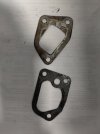carl
True Classic
Over the years, I have had both issues. Installing the wrong thermostat gasket causing coolant to go where it shouldn't (back then I didn't know about the different gaskets). Also had coolant leak at the waterpump/pipe joint when I didn't get the gasket right and the gasket had slipped down on the engine side and the bolt hole fell below the bolt opening.
Pull the thermostat and check that you have the right gasket for starters. Otherwise we are all whistling in the dark.
Wouldn't hurt to do a compression test.
Pull the thermostat and check that you have the right gasket for starters. Otherwise we are all whistling in the dark.
Wouldn't hurt to do a compression test.

